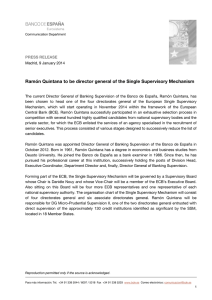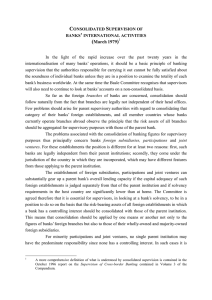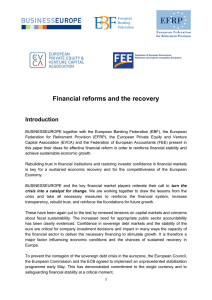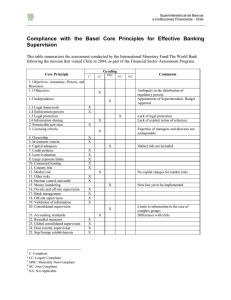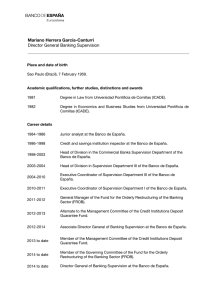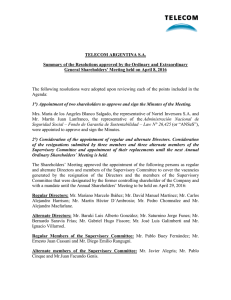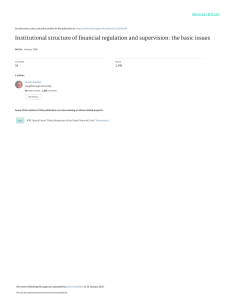The organisation of financial supervision
Anuncio
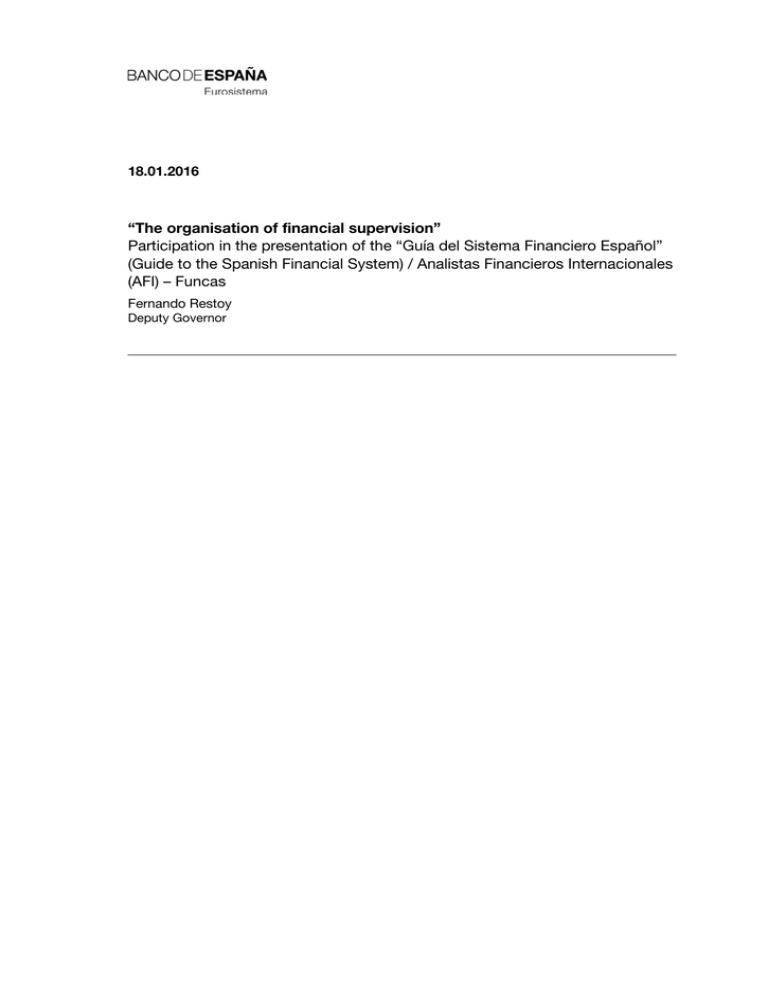
18.01.2016 “The organisation of financial supervision” Participation in the presentation of the “Guía del Sistema Financiero Español” (Guide to the Spanish Financial System) / Analistas Financieros Internacionales (AFI) – Funcas Fernando Restoy Deputy Governor Introduction Good afternoon. I should like to thank Emilio Ontiveros for his invitation to participate in the presentation of the seventh edition of the Guide to the Spanish Financial System, compiled by AFI and sponsored by Funcas. Thank you, also, Emilio, for your kind and, as ever, overly generous introductory words. The new version of the guide accurately details the numerous changes in the wake of the crisis, essentially owing to the start-up of the banking union in Europe and to the considerable reinforcement of regulatory requirements. As a result, the guide firmly stakes its claim as a reference that has proven extraordinary useful for helping to understand the complex mesh of Spanish and European rules and institutions that make up the regulatory and supervisory framework of our financial system. This presentation also affords me an excellent opportunity to reflect on the different models for the institutional organisation of financial supervision and, in particular, on the possibility of making further adjustments to the supervisory structure currently prevalent in Spain. That will be the focal point of my address. In this connection, I shall begin by discussing how supervisory structures have developed in the main European countries; next, I shall refer to the changes brought on by the banking union; and finally, I shall conclude with some comments on the Spanish supervisory model. The organisation of supervision in the European countries Financial supervision pursues numerous aims, encompassing the safeguarding of financial stability, the proper functioning of securities markets and investor protection. These aims are linked to specific functions such as oversight of the solvency position and liquidity of banks, insurance companies and other leveraged institutions whose activity involves risk transformation; and monitoring of the conduct of institutions, intermediaries and other participants in the markets for financial products and services. Recently added to these functions are the so-called macroprudential policies, geared to the containment of macro-financial risks, and the management of orderly resolution procedures for systemically important institutions. The adoption of a model of supervisory organisation involves defining a certain number of supervisory agencies and assigning to each of them a specific scope of action, clearly defined objectives and the instruments needed to achieve them. Historically, the models chosen have been the result of the assessment by the authorities of elements such as the structure of the supervised sector, the need to ensure a sufficient institutional efficiency, harnessing the synergies between different supervisory tasks, or the need to forestall the emergence of potential conflicts between the objectives assigned to a single agency. The experience accrued during periods of crisis and the changes that have taken place in the financial industry have conditioned the authorities’ preferences over time. For instance, until the end of the last century, the prevalent worldwide model was one of allocation of supervisory responsibilities by sector (banking, insurance and securities 3/9 markets). This model typically included a supervisor – normally the central bank – which was charged with ensuring that credit institutions complied with the sectoral regulations on solvency and conduct; a second supervisor, with similar competencies for insurance companies; and a third supervisor, which oversaw the behaviour of securities market participants. This model responded well to an industry structure in which the various types of institutions primarily pursued their activity in a single sector – whether banking, insurance or securities markets – and to the absence of widespread concern over the existence of possible conflicts between the surveillance of institutions’ solvency soundness and the monitoring of their behaviour with customers and investors. In the mid-1990s, this sectoral model began to be replaced in many countries by a single supervisory authority model (following the paradigm of the reform implemented in the United Kingdom in 1997) in which the oversight of banks, markets and insurance companies, in terms of both solvency and conduct, was assigned to a single supervisory agency separate from the central bank. It was sought thereby to acknowledge the growing presence of institutions operating in the different realms of financial activity, and the increase in large financial conglomerates, which blurred the old sectoral boundaries. Moreover, the single supervisory authority model enabled the synergies existing in the supervision – whether prudential or conductrelated – of different types of institutions to be harnessed. Finally, this model sought to prevent potential conflicts of interest between monetary policy, which remained in the hands of the central bank, and financial supervision, which was entirely the responsibility of a separate agency. More recently, especially in the wake of the crisis that broke in 2008, the twin peaks model has become more widespread in Europe. Under this model supervision is structured around two agencies: the first, set up within the realm of the central bank, is entrusted with the prudential oversight of all institutions capable of generating systemic risk (be these deposit-taking institutions, insurance companies or market intermediaries); the second agency is tasked with monitoring the conduct of all types of intermediaries and with pursuing the protection of investors in or consumers of all financial products and services. Compared with the single supervisory authority model, the twin peaks model seeks to protect the system from potential conflicts of interest between the monitoring of financial institutions’ solvency and the oversight of rules of conduct and of market integrity. At the same time, with the integration of prudential supervision into the central bank, the twin peaks model strengthens the capacity to preserve the stability of the financial system by promoting the necessary coordination between the management of the banking sector’s liquidity (a function which corresponds to the central bank) and the monitoring of credit institutions’ solvency soundness (which prudential supervision looks after). The predominance of the twin peaks model in the various national jurisdictions of the EU has scarcely been affected by the emergence of two new supervisory functions: the management of the resolution of non-viable institutions and the adoption of macroprudential policies to prevent the emergence of potential macro-financial imbalances and mitigate their destabilising effects. 9 4/9 As a general rule, the orderly resolution function has been allocated within the realm of the prudential supervisor. In the case of macroprudential policy, there is broad consensus that it is the central bank that should exercise leadership of macro-financial stability committees where government representatives and other supervisors may also participate. Hence, in those EU countries where the twin peaks model has been adopted (such as the United Kingdom, France, Italy, the Netherlands and Belgium), the central bank not only acts as the prudential supervisor of all types of financial institutions, but in addition, depending on the case, and by means of special committees and inserting Chinese walls between the different functions, it also manages or leads resolution and macroprudential policy measures. Banking union The development of the banking union has had an appreciable impact on the organisation of supervision in Europe. In particular, national supervisors have relinquished competencies to European authorities, although solely in the area of prudential oversight and resolution policy for deposit-taking institutions. Competencies relating to oversight of the solvency of other intermediaries – such as insurance companies or investment firms – and of compliance with rules of conduct by all financial institutions remain under the stewardship of the national authorities. These, as is moreover appropriately reflected in the report presented today, actively contribute to the supervisory and resolution functions exercised in respect of significant banking institutions at the European level, and they retain their jurisdiction over less significant institutions. Accordingly, the relinquishing of sovereignty entailed by the banking union has not generally altered the organisation of financial supervision at the national level, although it has required the establishment of new European agencies that have assumed the competencies transferred from national jurisdictions. Indeed, the organisation of the banking union adheres to a model involving a significantly stricter separation of functions than that prevailing in national jurisdictions. Thus, two independent authorities have been created: the Single Supervisory Mechanism, which turns on the ECB, and the Single Resolution Mechanism, which does so on the Board of the same name. Moreover, although the ECB’s supervisory decisions are formally adopted by its Governing Council – which also defines monetary policy – these are prepared and pre-agreed by an independent Supervisory Board, meaning that the Governing Council acts only under the principle of non-objection. Hence, when defining the institutional model of the banking union, the European legislator has set great store by preventing conflicts of interest between micro-and macroprudential supervision and monetary policy, on one hand, and between supervision and bank resolution, on the other. The aim is to mitigate the risk of monetary policy, geared to maintaining price stability, being tainted by considerations relating to financial stability, and to separate as far as possible the policies aimed at preventing solvency crises, which are pursued by the Single Supervisory Mechanism, from those geared to managing such crises, which are the remit of the Single Resolution Mechanism. 5/9 The appropriate functioning of this model, based on the principle of separation, nevertheless requires the intense cooperation and coordination of the different authorities involved. In the case of the interaction between monetary and prudential policies, the necessary cooperation arises from the complementarity, at least in the medium term, between macroeconomic stability and financial stability and, above all, from the potential impact of the instruments available in one area on the objective pursued in the other. Consider, for instance, the influence that the level of interest rates, which is decided by the central bank, has on variables so closely related to financial stability as the desire of banks and other agents to assume risk, or changes in financial asset prices. Alternatively, bear in mind the effect of the bank prudential requirements on the supply of credit for financing the economy and, therefore, on activity and prices. Therefore, given the evident interaction between the realms of monetary policy and of prudential policy, it is essential that the principle of separation between them should be applied with the appropriate measures of flexibility and pragmatism. In the case of the relationship between prudential oversight and resolution measures, the need for coordination is even more marked. The Regulation governing the creation of the Single Resolution Mechanism confers on the latter not only the management of orderly resolution processes for ailing institutions, but also the prerogative to initiate the process by declaring an institution non-viable (a competence it shares with the supervisor) and, to this end, it empowers it to gather all the information it needs and to conduct its own inspections. That is to say, without appropriate coordination, there is a risk that vulnerable institutions – which are naturally those that require more attention by the prudential supervisor – may be subjected to the dual scrutiny of the two agencies, and that discrepancies and frictions may emerge that may complicate the task of maintaining financial stability. Fortunately, so far, there is patent goodwill to reach an understanding between the European authorities responsible for the Single Resolution and Supervision Mechanisms, which will shortly take the form of a memorandum of understanding between the two that will contribute to attaining the required coordination. What has still to be done in Spain? The institutional framework of supervision in Spain has evolved so as to adapt to the new European and global regulatory framework, and to the establishment of the banking union. That said, the task is not yet complete. In respect of macroprudential policies, the Banco de España has, as a result of the new regulations on capital requirements, assumed the competencies over the potential activation of macroprudential instruments that involve actions related to credit institutions. Indeed, last December, the central bank adopted the first decisions in this respect entailing the identification of institutions considered systemic at the domestic level, the determining of the additional regulatory capital required of each of them and the setting of the countercyclical capital buffer envisaged under the regulations. Given the current cyclical position of the Spanish economy following the sharp contraction in GDP and credit levels since 2008, the buffer was initially set at a level equal to zero. 9 6/9 However, Spain is still lacking a macroprudential committee or forum, on which government authorities and financial supervisors are represented, that can assess macrofinancial conditions from a broad perspective and that has the capacity to formulate recommendations on public policies that may affect financial stability. Such committees have been set up in practically all EU Member States, normally under the leadership of the central bank, following the recommendation made by the European Systemic Risk Board, on which all EU regulatory and supervisory authorities and central banks are represented. With regard to resolution functions, Spain has already adapted to European regulatory requirements. In this connection it has adopted a structure in which the resolution preparation and planning tasks are assigned to the sectoral supervisors [the Banco de España for banks and the CNMV (National Securities Market Commission) for investment firms], and those relating to the implementation of resolution measures are assigned to the FROB (Fund for the Orderly Restructuring of the Banking Sector). As you know, the FROB is also responsible for the management and ultimate divestment of the stakes the State holds in the capital of banks subject to restructuring plans as a result of State aid granted during the crisis. These arrangements are admittedly more complex than those adopted in most Member States, which have placed all resolution functions – preventive and executive alike – under the remit of the national prudential supervisor. In Spain, coordination between the resolution authorities and between these and the prudential supervisor is so far functioning smoothly. In any event, the preamble to Law 11/2015 establishes that these arrangements for the allocation of functions should be assessed once – within two years - the implementation of the restructuring plans currently under way has been completed, in light of the experience acquired, with a view to achieving greater efficiency. All told, as regards the organisation of the traditional supervisory functions, namely solvency, conduct and investor protection, Spain retains a sectoral approach which, as indicated earlier, was abandoned some time back by our peers. Hence, the Banco de España retains supervisory competencies for the solvency of credit institutions and also for their conduct, as regards the marketing and selling of loan and deposit products. The CNMV, meanwhile, in addition to overseeing the functioning of markets, supervises the solvency and conduct of investment firms and other capital market intermediaries (such as investment fund management companies), and the commercialization of financial products classified as securities. Finally, the Directorate General for Insurance and Pension Funds oversees the solvency and conduct of companies in the insurance sector, along with the operations of pension funds and their management companies. These authorities also manage enquiries and claims services in their respective areas and are empowered to issue reports on disputes between the different institutions and their customers, although, as you know, such reports are not binding. This sectoral supervisory model, which – I insist – is an oddity in the European arena, does not take on board the key lessons from the financial crisis as regards the most suitable means of preventing potential conflicts of interest and of ensuring that the synergies existing between the different oversight functions are harnessed. Moreover, it establishes different supervisory regimes - entailing investor protection arrangements that are not 7/9 uniform - as regards the marketing and selling of financial products, based on categories that classify them, sometimes somewhat artificially, as a security, banking product or insurance product. Finally, the institutional framework in place in Spain has always kept a segment of the financial system – that comprising insurance companies and pension funds – under the surveillance of an agency reporting directly to the Government of the day, contrary to what is predicated by supervisory standards and best international practices. The situation is somewhat similar regarding audit firms, which also play a key role in the proper functioning of the financial system and capital markets, and whose supervision has, historically, also been exercised by an agency that is not independent from the Government. The need to modernise the organisation of supervision, in order to adjust it to the twin peaks model prevailing in Europe, was at that time widely defended by the public authorities. For example, for the 2008 general elections, the two main political parties advocated in their respective electoral programmes very similar plans to reform the supervisory model along the lines indicated above. Under these plans, competencies in respect of financial stability and the prudential oversight of all types of financial intermediaries (banks, investment firms and insurance companies) would be under the roof of a single authority, integrated into the Banco de España; and responsibility for the oversight of markets and the supervision of the conduct of financial intermediaries would be assigned to a second agency established drawing on the current CNMV. The outbreak of the financial crisis shortly afterwards and the need to manage the delicate situation of the banking system, up until very recently, advised against implementing at that time an institutional reform which, undoubtedly, would have involved a considerable organisational challenge. At present, following the completion of the intense process of restructuring and reform of the banking system, the circumstances for resuming reflection on an ambitious reform of the institutional model for supervision are admittedly more favourable. I thus believe it would be worth considering again plans to reform the supervisory framework, taking as a reference, as was envisaged in 2008, the twin peaks model prevailing in Europe. In any event, the new supervisory model should be adjusted to accommodate, as it has in other countries, the setting up of a macroprudential committee (on which government authorities and supervisors would sit) coordinated by the Banco de España. Further, so as to reinforce the investor protection function, we should also explore the possibility of incorporating into the new framework a reinforced system for resolving conflicts between financial institutions and their customers – the current claims systems – that would provide for the issuing of binding rulings for the institutions concerned. Final remarks Ultimately and unquestionably, notable steps have been taken to adjust the organisation of financial supervision in Spain to the new demands of the regulatory and institutional environment in Europe. 9 8/9 That said, drawing on the reforms successfully applied in other jurisdictions akin to ours, it would be worth reflecting on additional changes that contribute to facilitating the preservation of financial stability, suitably protecting investors in and users of all types of financial services, ensuring the proper functioning of markets and providing for the effective management of financial crises with the minimum possible cost to taxpayers. In that connection, the right choice must be made in assigning specific objectives and instruments to the different agencies so that potential conflicts of interest may be mitigated while maintaining an appropriate level of institutional efficiency and ensuring the functional and economic independence of the supervisory bodies. I believe that the costly financial crisis we have just experienced is the best possible motivation for undertaking this reform when circumstances so allow it. 9/9
